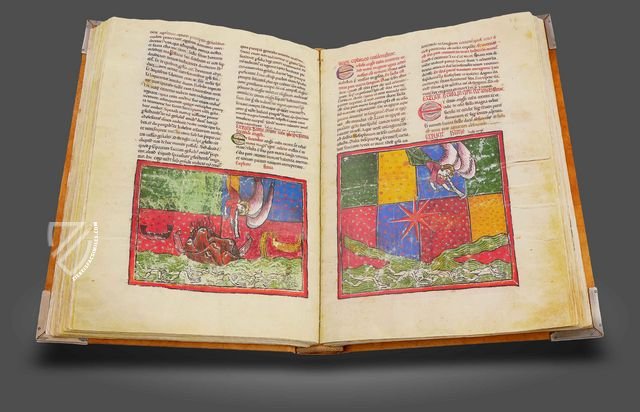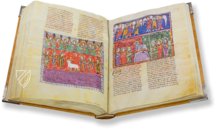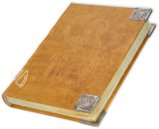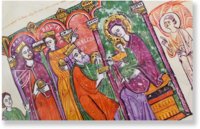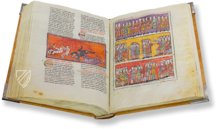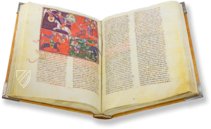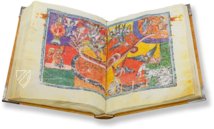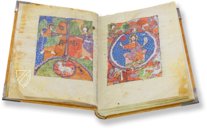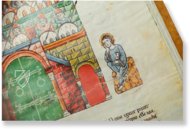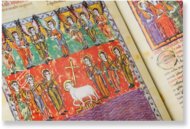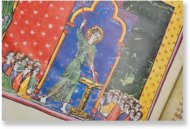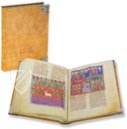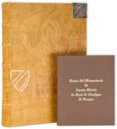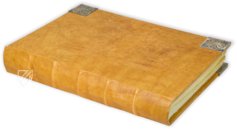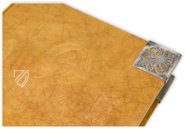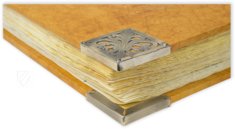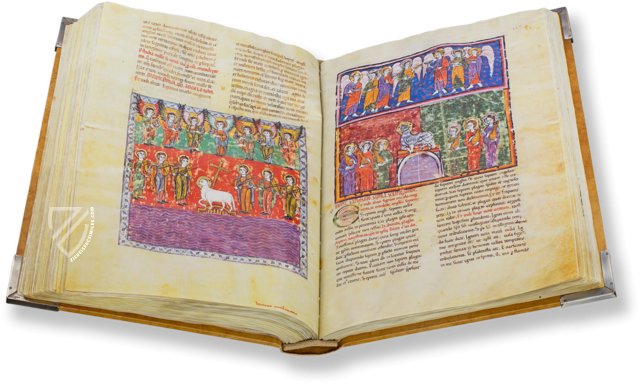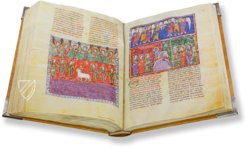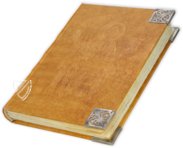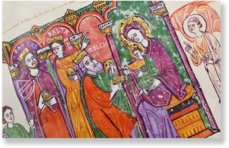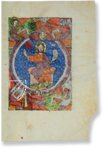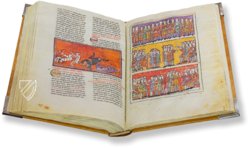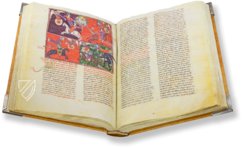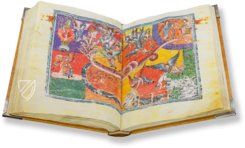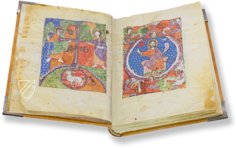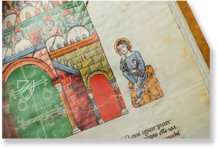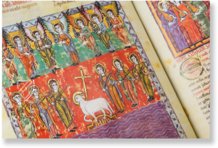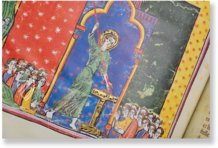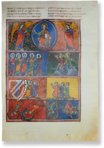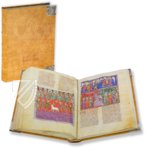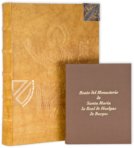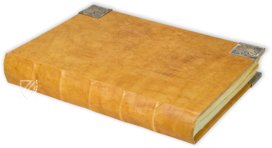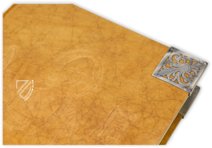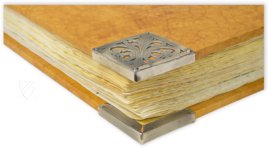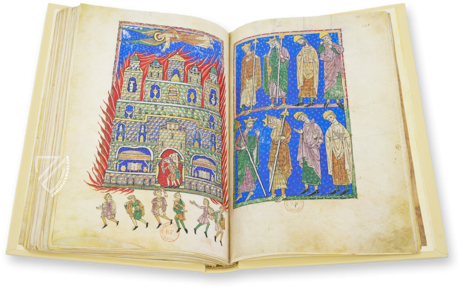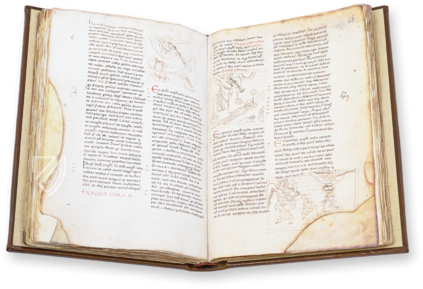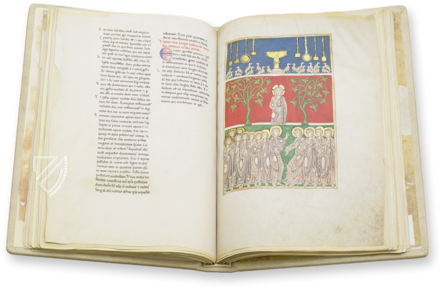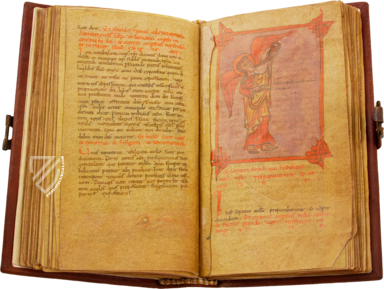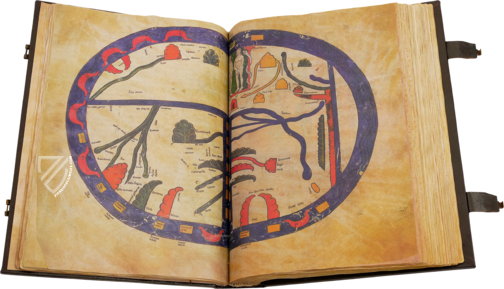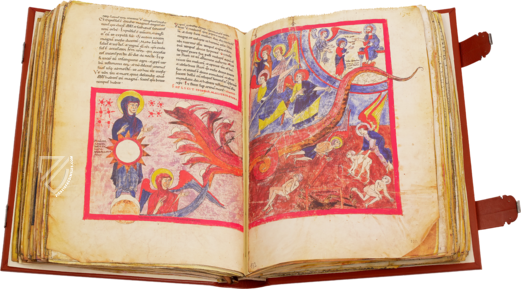Beatus of Liébana - Huelga Codex
(3,000€ - 7,000€)
In the Royal Abbey of Las Huelgas, the last and simultaneously the greatest of the magnificent Beatus manuscripts arose from northern Spain in the year 1220. At the behest of Berenguela de Castilla, the daughter of King Alfonso VIII, true masters of their craft completed an impressive work of art. The well over 100 miniatures, which sometimes even stretch across a double page, firstly allow the tradition of the Beatus manuscripts to be wonderfully understood. However, the miniatures likewise present innovative reinventions to the illustration of the famous Apocalypse commentary of Beatus of Liébana. The splendidly colorful miniatures overwhelm in their unmediated force allow the fantastical world of the Book of Revelation to come to life before the eyes of the beholder. It simultaneously offers a glimpse into the grandiose tradition of illumination in medieval Spain.
Beatus of Liébana - Huelga Codex
In the Royal Abbey of Las Huelgas, the last and simultaneously the greatest of the magnificent Beatus manuscripts arose from northern Spain in the year 1220. At the behest of Berenguela de Castilla, the daughter of King Alfonso VIII, true masters of their craft completed an impressive work of art. The well over 100 miniatures, which sometimes even stretch across a double page, firstly allow the tradition of the Beatus manuscripts to be wonderfully understood. However, the miniatures likewise present innovative reinventions to the illustration of the famous Apocalypse commentary of Beatus of Liébana. The splendidly colorful miniatures overwhelm in their unmediated force allow the fantastical world of the Book of Revelation to come to life before the eyes of the beholder. It simultaneously offers a glimpse into the grandiose tradition of illumination in medieval Spain.
A Royal Monastery
The gem of the final phase of the Beatus manuscript is found today in the Morgan Library in New York. An exciting history is wrapped around the so-called Beatus of Las Huelgas. The manuscript originated in the year 1220 in the Las Huelgas Abbey near Burgos. The Abbey of Los Huelgas was a royal cloister, founded by the Castilian King Alfonso VIII. The great significance of Las Huelgas is evidenced among other things by an outstanding collection of codices. It was precisely in this abbey that Berenguela de Castilla died on November 8, 1246.
The Important Commissioner
Berenguela de Castilla (1180–1246) is presumed to be the commissioner of the Huelga Codex. She was the daughter of King Alfonso VIII of Castile and Eleanor Plantagenet, as well as the mother of King Fernando III. In the year 1217, Berenguela, as the only child of the king at the time, was the Queen of Castile, albeit briefly. The splendid manuscript of the Huelga Codex is worthy all-around of such an important commissioner. The grandiose format of 52 x 36.4 cm already makes the codex something special. Yet the greatest and last manuscript of the Apocalypse commentaries of Beatus of Liébana unfolds a splendor from within, which can probably overwhelm any beholder.
The Exciting Apocalypse, the Genealogy of Christ, and More.
On 368 pages, the Huelga Codex presents 116 miniatures, which sometimes stretch across a double page. As to content, the manuscript begins with a cycle of Christological miniatures. An impressive Maiestas Domini and representations of the four Evangelists present the outstanding style of the miniatures. The eight miniatures of the prefacing cycle originate from a master, who was probably located in Toledo. An extensive genealogy of Christ familiarizes the reader with the biblical background. Thereafter follows the actual Apocalypse and lastly the Book of Daniel with the accompanying commentary by St. Jerome.
The Last Great Beatus
Originating in the year 1220, the Beatus of Los Huelgas presents miniatures in the Gothic style. This is especially perceptible in the figures, which appear exceedingly slender and graceful. The miniaturists oriented themselves on numerous examples, e.g. the arrangement of the miniatures on monochrome, bright backgrounds and in narrow, simple frames. The miniatures are sometimes subdivided into several registers and show symbolic scenes from the Book of Revelation. Colorful crowds of people, gruesome denizens of hell, the Horsemen of the Apocalypse, and magnificent angels populate the depictions. Sometimes the events play out before impressive city architectures, with embellishing columns, artful capitals, and grandiose archways. The intensively luminous colors lend the miniatures their vividness and their impressive pull on the beholder. As simultaneously the last and most comprehensive Beatus manuscript, the Huelga Codex offers therewith a wonderful overview of the tradition of Beatus manuscripts, which the miniaturists could substantially draw from. Nevertheless, the artists likewise presented themselves as exceptionally innovative by expanding traditional iconography to new representations.
Codicology
- Alternative Titles
- Las Huelgas Apocalypse
Beatus Las Huelgas
Apocalipsis de San Juan
Beato de Liebana - Monasterio de Las Huelgas - Size / Format
- 368 pages / 52.0 × 36.4 cm
- Origin
- Spain
- Date
- 1220
- Epochs
- Style
- Genre
- Language
- Script
- Carolingian minuscule
- Illustrations
- 116 miniatures
- Content
- Commentary on the Book of Revelation by Beatus of Liébana
Commentary on the Book of Daniel by Saint Jerome - Patron
- Berenguela, mother of Fernando III and sister of Alphose VIII
- Artist / School
- Beatus of Liébana (died after 798) (author)
Beatus of Liébana - Huelga Codex
Christ in Majesty
Within a circular mandorla supported by angels, Christ sits enthroned with bare feet resting on a footstool before a starry heaven and flanked by the sun and moon. Christ’s right hand is extended in the sign of benediction while his left holds a book displaying the words EGO SVM ALFA ET OMEGA. The golden crossed-halo on his head is lined with pearls and his robes possess a very naturalistic fall of folds made possible through subtle coloration and shading.
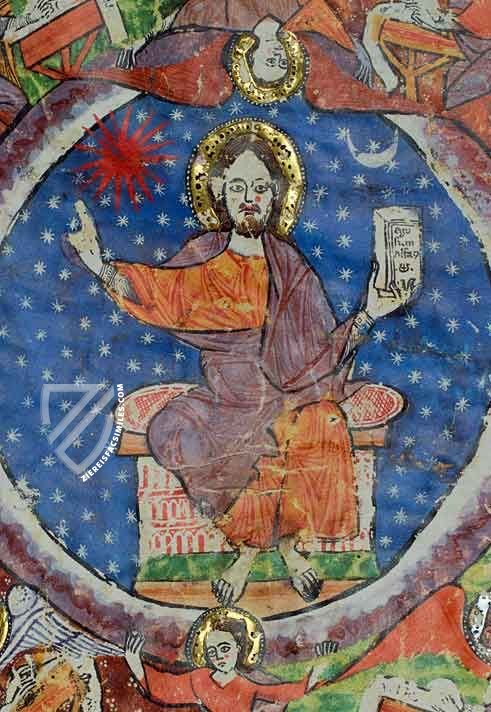
Beatus of Liébana - Huelga Codex
Victorious Cross Of Oviedo
The Cross of Oviedo is commonly found at the beginning of a Beatus manuscript and is named after the Greek-shaped crosses found in the treasury of Oviedo Cathedral. These imitate the cross carried by Pelayo of Asturias in his victory over the Moors at the Battle of Covadonga in 722, which first stemmed the tide of Moorish conflict in Spain, beginning the Reconquista.
Here, the Master of the Prefatory Pages associates the cross with the symbolism of the Passion. The cross, rooted in the Lamb of God, is flanked by two angels, one holding the spear and sponge. The crown of thorns and the three nails float above the arms of the cross, the Greek symbols for Alpha and Omega below. The cross, their halos, and the Lamb’s halo are highlighted in gold leaf.
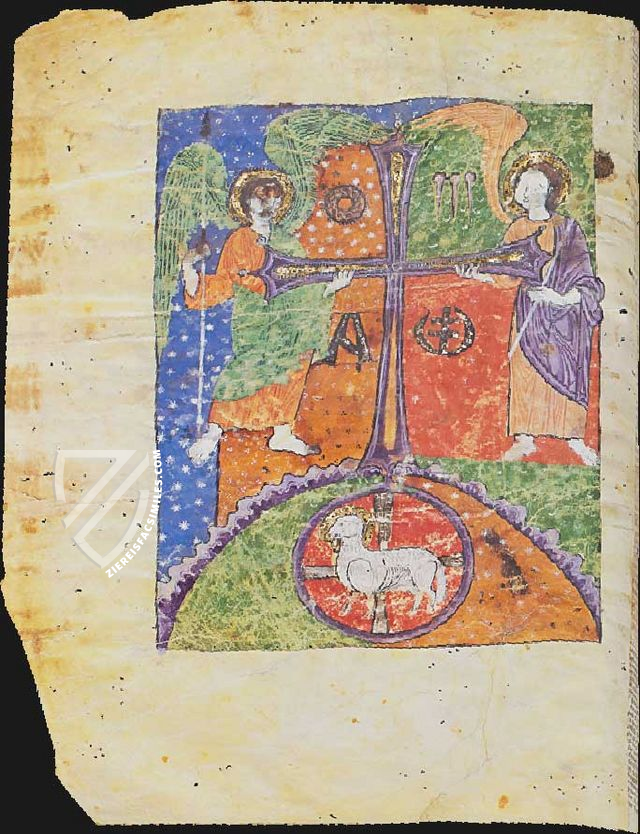
#1 Apocalipsis de San Juan. Beato de Liébana Monasterio de las Huelgas Beatus of Liébana - Las Huelgas Codex
Language: Spanish
(3,000€ - 7,000€)
- Treatises / Secular Books
- Apocalypses / Beatus
- Astronomy / Astrology
- Bestiaries
- Bibles / Gospels
- Chronicles / History / Law
- Geography / Maps
- Saints' Lives
- Islam / Oriental
- Judaism / Hebrew
- Single Leaf Collections
- Leonardo da Vinci
- Literature / Poetry
- Liturgical Manuscripts
- Medicine / Botany / Alchemy
- Music
- Mythology / Prophecies
- Psalters
- Other Religious Books
- Games / Hunting
- Private Devotion Books
- Other Genres
- Afghanistan
- Armenia
- Austria
- Belgium
- Belize
- Bosnia and Herzegovina
- China
- Colombia
- Costa Rica
- Croatia
- Cyprus
- Czech Republic
- Denmark
- Egypt
- El Salvador
- Ethiopia
- France
- Germany
- Greece
- Guatemala
- Honduras
- Hungary
- India
- Iran
- Iraq
- Israel
- Italy
- Japan
- Jordan
- Kazakhstan
- Kyrgyzstan
- Lebanon
- Liechtenstein
- Luxembourg
- Mexico
- Morocco
- Netherlands
- Palestine
- Panama
- Peru
- Poland
- Portugal
- Romania
- Russia
- Serbia
- Spain
- Sri Lanka
- Sweden
- Switzerland
- Syria
- Tajikistan
- Turkey
- Turkmenistan
- Ukraine
- United Kingdom
- United States
- Uzbekistan
- Vatican City
- A. Oosthoek, van Holkema & Warendorf
- Aboca Museum
- Ajuntament de Valencia
- Akademie Verlag
- Akademische Druck- u. Verlagsanstalt (ADEVA)
- Aldo Ausilio Editore - Bottega d’Erasmo
- Alecto Historical Editions
- Alkuin Verlag
- Almqvist & Wiksell
- Amilcare Pizzi
- Andreas & Andreas Verlagsbuchhandlung
- Archa 90
- Archiv Verlag
- Archivi Edizioni
- Arnold Verlag
- ARS
- Ars Magna
- ArtCodex
- AyN Ediciones
- Azimuth Editions
- Badenia Verlag
- Bärenreiter-Verlag
- Belser Verlag
- Belser Verlag / WK Wertkontor
- Benziger Verlag
- Bernardinum Wydawnictwo
- BiblioGemma
- Biblioteca Apostolica Vaticana (Vaticanstadt, Vaticanstadt)
- Bibliotheca Palatina Faksimile Verlag
- Bibliotheca Rara
- Boydell & Brewer
- Bramante Edizioni
- Bredius Genootschap
- Brepols Publishers
- British Library
- C. Weckesser
- Caixa Catalunya
- Canesi
- CAPSA, Ars Scriptoria
- Caratzas Brothers, Publishers
- Carus Verlag
- Casamassima Libri
- Centrum Cartographie Verlag GmbH
- Chavane Verlag
- Christian Brandstätter Verlag
- Circulo Cientifico
- Club Bibliófilo Versol
- Club du Livre
- CM Editores
- Collegium Graphicum
- Collezione Apocrifa Da Vinci
- Comissão Nacional para as Comemorações dos Descobrimentos Portugueses
- Coron Verlag
- Corvina
- CTHS
- D. S. Brewer
- Damon
- De Agostini/UTET
- De Nederlandsche Boekhandel
- De Schutter
- Deuschle & Stemmle
- Deutscher Verlag für Kunstwissenschaft
- DIAMM
- Droz
- E. Schreiber Graphische Kunstanstalten
- Ediciones Boreal
- Ediciones Grial
- Ediclube
- Edições Inapa
- Edilan
- Editalia
- Edition Deuschle
- Edition Georg Popp
- Edition Leipzig
- Edition Libri Illustri
- Editiones Reales Sitios S. L.
- Éditions de l'Oiseau Lyre
- Editions Medicina Rara
- Editorial Casariego
- Editorial Mintzoa
- Editrice Antenore
- Editrice Velar
- Edizioni Edison
- Egeria, S.L.
- Eikon Editores
- Electa
- Emery Walker Limited
- Enciclopèdia Catalana
- Eos-Verlag
- Ephesus Publishing
- Ernst Battenberg
- Eugrammia Press
- Extraordinary Editions
- Fackelverlag
- Facsimila Art & Edition
- Facsimile Editions Ltd.
- Facsimilia Art & Edition Ebert KG
- Faksimile Verlag
- Feuermann Verlag
- Folger Shakespeare Library
- Franco Cosimo Panini Editore
- Friedrich Wittig Verlag
- Fundación Hullera Vasco-Leonesa
- G. Braziller
- Gabriele Mazzotta Editore
- Gebr. Mann Verlag
- Gesellschaft für graphische Industrie
- Getty Research Institute
- Giovanni Domenico de Rossi
- Giunti Editore
- Graffiti
- Grafica European Center of Fine Arts
- Guido Pressler
- Guillermo Blazquez
- Gustav Kiepenheuer
- H. N. Abrams
- Harrassowitz
- Harvard University Press
- Helikon
- Hendrickson Publishers
- Henning Oppermann
- Herder Verlag
- Hes & De Graaf Publishers
- Hoepli
- Holbein-Verlag
- Houghton Library
- Hugo Schmidt Verlag
- Idion Verlag
- Il Bulino, edizioni d'arte
- ILte
- Imago
- Insel Verlag
- Insel-Verlag Anton Kippenberger
- Instituto de Estudios Altoaragoneses
- Instituto Nacional de Antropología e Historia
- Introligatornia Budnik Jerzy
- Istituto dell'Enciclopedia Italiana - Treccani
- Istituto Ellenico di Studi Bizantini e Postbizantini
- Istituto Geografico De Agostini
- Istituto Poligrafico e Zecca dello Stato
- Italarte Art Establishments
- Jan Thorbecke Verlag
- Johnson Reprint Corporation
- Josef Stocker
- Josef Stocker-Schmid
- Jugoslavija
- Karl W. Hiersemann
- Kasper Straube
- Kaydeda Ediciones
- Kindler Verlag / Coron Verlag
- Kodansha International Ltd.
- Konrad Kölbl Verlag
- Kurt Wolff Verlag
- La Liberia dello Stato
- La Linea Editrice
- La Meta Editore
- Lambert Schneider
- Landeskreditbank Baden-Württemberg
- Leo S. Olschki
- Les Incunables
- Liber Artis
- Library of Congress
- Libreria Musicale Italiana
- Lichtdruck
- Lito Immagine Editore
- Lumen Artis
- Lund Humphries
- M. Moleiro Editor
- Maison des Sciences de l'homme et de la société de Poitiers
- Manuscriptum
- Martinus Nijhoff
- Maruzen-Yushodo Co. Ltd.
- MASA
- Massada Publishers
- McGraw-Hill
- Metropolitan Museum of Art
- Militos
- Millennium Liber
- Müller & Schindler
- Nahar - Stavit
- Nahar and Steimatzky
- National Library of Wales
- Neri Pozza
- Nova Charta
- Oceanum Verlag
- Odeon
- Orbis Mediaevalis
- Orbis Pictus
- Österreichische Staatsdruckerei
- Oxford University Press
- Pageant Books
- Parzellers Buchverlag
- Patrimonio Ediciones
- Pattloch Verlag
- PIAF
- Pieper Verlag
- Plon-Nourrit et cie
- Poligrafiche Bolis
- Presses Universitaires de Strasbourg
- Prestel Verlag
- Princeton University Press
- Prisma Verlag
- Priuli & Verlucca, editori
- Pro Sport Verlag
- Propyläen Verlag
- Pytheas Books
- Quaternio Verlag Luzern
- Reales Sitios
- Recht-Verlag
- Reichert Verlag
- Reichsdruckerei
- Reprint Verlag
- Riehn & Reusch
- Roberto Vattori Editore
- Rosenkilde and Bagger
- Roxburghe Club
- Salerno Editrice
- Saltellus Press
- Sandoz
- Sarajevo Svjetlost
- Schöck ArtPrint Kft.
- Schulsinger Brothers
- Scolar Press
- Scrinium
- Scripta Maneant
- Scriptorium
- Shazar
- Siloé, arte y bibliofilia
- SISMEL - Edizioni del Galluzzo
- Sociedad Mexicana de Antropología
- Société des Bibliophiles & Iconophiles de Belgique
- Soncin Publishing
- Sorli Ediciones
- Stainer and Bell
- Studer
- Styria Verlag
- Sumptibus Pragopress
- Szegedi Tudomànyegyetem
- Taberna Libraria
- Tarshish Books
- Taschen
- Tempus Libri
- Testimonio Compañía Editorial
- Thames and Hudson
- The Clear Vue Publishing Partnership Limited
- The Facsimile Codex
- The Folio Society
- The Marquess of Normanby
- The Richard III and Yorkist History Trust
- Tip.Le.Co
- TouchArt
- TREC Publishing House
- TRI Publishing Co.
- Trident Editore
- Tuliba Collection
- Typis Regiae Officinae Polygraphicae
- Union Verlag Berlin
- Universidad de Granada
- University of California Press
- University of Chicago Press
- Urs Graf
- Vallecchi
- Van Wijnen
- VCH, Acta Humaniora
- VDI Verlag
- VEB Deutscher Verlag für Musik
- Verlag Anton Pustet / Andreas Verlag
- Verlag Bibliophile Drucke Josef Stocker
- Verlag der Münchner Drucke
- Verlag für Regionalgeschichte
- Verlag Styria
- Vicent Garcia Editores
- W. Turnowski Ltd.
- W. Turnowsky
- Waanders Printers
- Wiener Mechitharisten-Congregation (Wien, Österreich)
- Wissenschaftliche Buchgesellschaft
- Wissenschaftliche Verlagsgesellschaft
- Wydawnictwo Dolnoslaskie
- Xuntanza Editorial
- Zakład Narodowy
- Zollikofer AG

